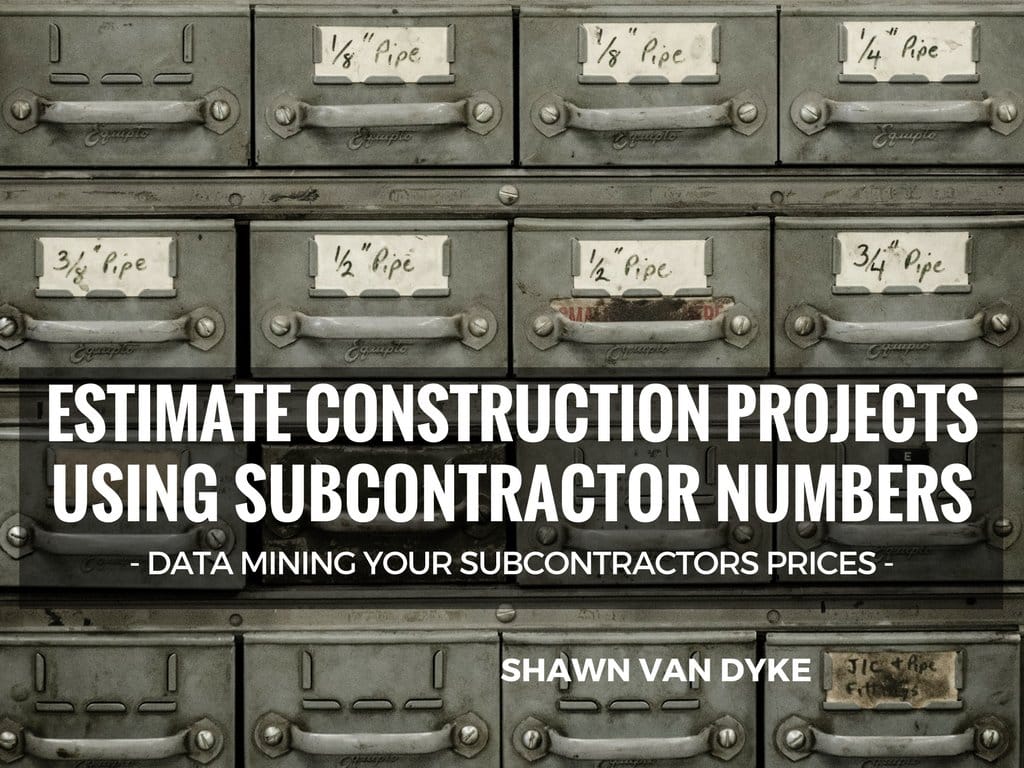Built to Build: Blog
How to Estimate a Construction Project with Subcontractors

As a general contractor, estimating construction projects accurately is key to running a successful business. However, the process can be overwhelming and time-consuming. It’s especially frustrating when you’re waiting on subcontractors to provide pricing information, causing delays and inefficiencies in your sales funnel.
Luckily, there’s a way to streamline the process and predict the cost of your subcontractors’ work. Data mining is an effective method that can help you develop a system to make more accurate estimates. By analyzing data patterns and historical information, you can gain insights into your subcontractors’ pricing and adjust your estimates accordingly. With this valuable tool, you can confidently estimate projects, secure more bids and ultimately boost your bottom line.
WHAT IS SUBCONTRACTOR DATA MINING?
Subcontractor data mining is the practice of examining databases in order to generate new information. This process can accurately estimate project budgets, empowering decision-makers to make informed choices. It’s worth noting, however, the system will not provide a quoted price for the final scope of work until the owner has agreed to the budget range beforehand.
To optimize profitability, mining the data from your subcontractors can serve as a valuable starting point for budget determination, which can then be integrated into a larger design process to enhance the saleability of your planning work.
HOW TO ESTIMATE A CONSTRUCTION PROJECT USING SUBCONTRACTORS
Step 1 – USE UNIT PRICES FOR CONSTRUCTION ESTIMATES
The easiest way to start developing your Subcontractor Data Mining system to simply ask your subcontractors how they price their work.
What do they charge per fixture, square foot, cubic yard, or hour?
The good subcontractors want to help you sell more work. More work for you means more work for them. Good subcontractors will tell you how they price their work.
All you have to do is ask.
Step 2 – DEVELOP A SCOPE OF WORK BASED ON UNIT PRICES
Once you know how a subcontractor prices his work, then provide him with a scope of work based on that format.
Instead of asking your plumber to come out and take a look at the job and give you a price, tell him how many fixtures he is going to rough in, what you think the set out will be, and how much rerouting he is going to do.
When you clearly communicate the scope of work to your subcontractor, you can ensure you are getting pricing for the complete scope of work you have discussed. This eliminates the “I didn’t have that in my price” conversation that often comes up once you are under contract with the owner.
But no one is perfect, and some things may get missed. That’s why the next step is so vital to this system.
Step 3 – PERFORM A PLAN-BASED REVIEW
No matter how good your data is, you always want to make sure your subcontractor quotes the work based on the plans and specifications of the job. You should be able to look at the plans and get a rough idea of the price, but you want to ensure your subcontractors always base their quotes or proposals on the plans and specifications. Review the plans and specifications with your subcontractors. You will get even more information for your database when you discuss the details of the project and learn how they price their work.
If you spend the time doing a plan-based review with your subcontractors, you will develop a very accurate system of predicting their prices.
You will also be able to detect when your subcontractors’ pricing is changing.
I am not saying that price changes are bad or unreasonable.
Pricing can and will change due to many reasons.
Performing a plan-based review of your project will ensure your database is up-to-date.
Step 4 – SIMPLIFY THE PRICING BASED ON THE DATA
After you have been mining your subcontractor’s prices for a few jobs, then you can start to simplify the data.
EXAMPLE:
Your electrician charges you $125 per box for rough-in and set out of switches and outlet (including materials).
Based on square footage of the last three jobs, this equates to roughly $3.00 per square foot.
You don’t have to count the number of boxes if this data has proven to be accurate.
Simplifying the data will speed up the estimating process.
Step 5 – MINE THE DATA
After several projects, you should see some consistency in your subcontractors’ pricing. If you can’t find some consistency in your subcontractors’ pricing, then you need to meet with them and show them what you found.
They may not be aware of this, and you could be helping them avoid some costly mistakes in their businesses.
What helps them helps you.
Step 6 – REANALYSE AND REFINE
Now that you have established a database of pricing information and understand how your subcontractors price certain types of work, you need to record and track this information over time. You will be able to spot trends and catch mistakes made by your subcontractors’ plan-based reviews and your own mistakes.
When you spot trends in the data in real time, you can refine your pricing sooner.
Each quote from your subcontractor is another data point in your system. This allows for constant analysis and refinement of your database.
SUB-CONTRACTOR ESTIMATES SUMMARY
Knowing how your subcontractors price their work will help you accurately predict the costs of your construction projects and will eliminate a lot of the guesswork involved in the early stages of determining your clients’ budgets.
In a previous post, I discussed finding and keeping good subcontractors.
Treating your subcontractors like you want to be treated by your clients is the best way to ensure a profitable and productive relationship with your subcontractors.
Data Mining your subcontractors’ prices will enable you to determine the overall price range for a given project without waiting for your subcontractors to respond to requests for pricing.
Developing an estimating system for construction projects that uses Subcontractor Data Mining not only removes the waiting period associated with the standard estimating process, but also ensures that you are asking your subcontractors to spend their precious time quoting jobs for your business that you have pre-qualified with “their” numbers.
Finding a good subcontractor who will educate you on his pricing system is like finding the mother lode – the source of something valuable in great abundance.
A final note:
The Subcontractor Data Mining system should never replace receiving an actual written quote or proposal from your subcontractor.
You should require all subcontractors to provide a written quote or proposal for every job based on the plans and specifications for that job. However, you should use the data this system produces to establish the budget for the project and pre-qualify your potential clients.
If you want to streamline your construction business and DOUBLE your profits next month…
Download my FREE book: The Paperwork Punch List

